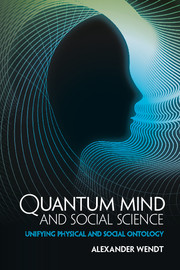Book contents
- Frontmatter
- Dedication
- Epigraph
- Contents
- Acknowledgments
- 1 Preface to a quantum social science
- Part I Quantum theory and its interpretation
- Part II Quantum consciousness and life
- 5 Quantum brain theory
- 6 Panpsychism and neutral monism
- 7 A quantum vitalism
- Part III A quantum model of man
- Part IV Language, light, and other minds
- Part V The agent-structure problem redux
- Conclusion
- Bibliography
- Index
5 - Quantum brain theory
from Part II - Quantum consciousness and life
Published online by Cambridge University Press: 05 May 2015
- Frontmatter
- Dedication
- Epigraph
- Contents
- Acknowledgments
- 1 Preface to a quantum social science
- Part I Quantum theory and its interpretation
- Part II Quantum consciousness and life
- 5 Quantum brain theory
- 6 Panpsychism and neutral monism
- 7 A quantum vitalism
- Part III A quantum model of man
- Part IV Language, light, and other minds
- Part V The agent-structure problem redux
- Conclusion
- Bibliography
- Index
Summary
In recent decades it has become common throughout the social sciences to think of the human mind simply as a very complex computer. Drawing on an older materialist metaphor of the mind as a machine, the “computational” model of the mind took off after the mid-century invention of the computer and subsequent cognitive revolution in psychology, and has since permeated the social sciences in the form of rational choice and other prominent social theories. The contributions of this model have been huge; but it has always been assumed that the computations going on inside our heads are classical. Quantum brain theory challenges this assumption by proposing that the mind is actually a quantum computer. Classical computers are based on binary digits or “bits” with well defined values (0 or 1), which are transformed in serial operations by a program into an output. Quantum computers in contrast are based on “qubits” that can be in superpositions of 0 and 1 at the same time and also interact non-locally, enabling every qubit to be operated on simultaneously. The idea of a quantum computer was first proposed in the 1980s and is still far from being realized technologically, but it has fired the imagination of scientists by raising the prospect of unimaginable increases in computational power, and other neat tricks besides. If quantum brain theory is true, then our model of the mind would be similarly radically altered, irrespective of the issue of consciousness.
Quantum brain theory hypothesizes that quantum processes at the elementary level are amplified and kept in superposition at the level of the organism, and then, through downward causation constrain what is going on deep within the brain. On this view, information from the environment is continuously transformed from the macro- to the micro-level, and then channeled back upward into an “internal quantum state,”
- Type
- Chapter
- Information
- Quantum Mind and Social ScienceUnifying Physical and Social Ontology, pp. 95 - 108Publisher: Cambridge University PressPrint publication year: 2015



